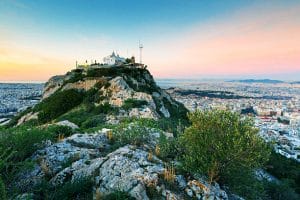The hill of Lycabettus in Athens
 Lycabettus hill is the highest point of Athens. According to mythology, the hill was formed by a rock carried by Athena from Penteli, going to the Acropolis, in order to make a small intervention in her temple, to increase its height a little. On the way he heard the mantas about the daughters of Kekropas, who had opened the basket which he had entrusted to keep, and in which Erichthonius was inside. The goddess was shaken, the rock fell from her hands, and it became what later the Athenians would call the hill of Lycabettus.
Lycabettus hill is the highest point of Athens. According to mythology, the hill was formed by a rock carried by Athena from Penteli, going to the Acropolis, in order to make a small intervention in her temple, to increase its height a little. On the way he heard the mantas about the daughters of Kekropas, who had opened the basket which he had entrusted to keep, and in which Erichthonius was inside. The goddess was shaken, the rock fell from her hands, and it became what later the Athenians would call the hill of Lycabettus.
The pine forest of Lycabettus was not always there. From 1830 onwards, the hill was bare, with many quarries on its slopes gnawing its soil. After many successive bans on their operation and the lifting of the bans, Lycabettus was first planted with trees in 1880. Those first trees became beautiful food for the goats grazing on the hillside. Somehow, reforestation efforts continued until 1915, when the goats dwindled and the trees were saved.
 Lycabettus was first illuminated in 1835, with a hundred lanterns forming a large Omicron, the original name of King Otto. The second illumination of the hill took place on March 25, 1838, with branches burning to form a flaming cross.Ernest Ziller had big plans for Lycabettus:
Lycabettus was first illuminated in 1835, with a hundred lanterns forming a large Omicron, the original name of King Otto. The second illumination of the hill took place on March 25, 1838, with branches burning to form a flaming cross.Ernest Ziller had big plans for Lycabettus:
In the late 19th century, he submitted to Charilaos Trikoupis a magnificent plan that would turn the hill into a recreation center, including a hotel, cafes, reading room, artificial waterfalls, fountains, and fountains. playgrounds.
The plan, apparently, was never implemented, as it was considered too expensive.
The Lycabettus Cannons, the ones that fire the festive shots on New Year’s Eve and the national anniversaries, were installed here in 1929. The Lighthouse of Peace was built near them in the early 1930s, which infuriated the then Mayor of Athens Spyros Mercouris with Power consumption. The German occupation troops destroyed the lighthouse in 1941, but the city’s economic problems did not improve much.
